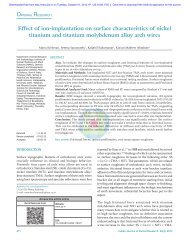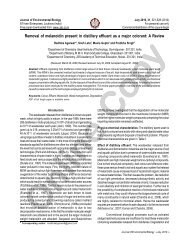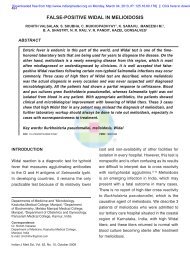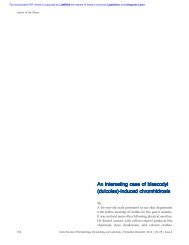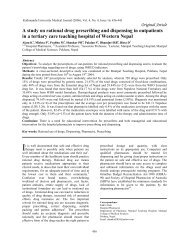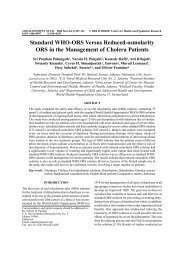Print this article - Nepal Journals Online
Print this article - Nepal Journals Online
Print this article - Nepal Journals Online
Create successful ePaper yourself
Turn your PDF publications into a flip-book with our unique Google optimized e-Paper software.
May-August, 2011/Vol 31/Issue 2<br />
Original Article<br />
Nosocomial Citrobacter Infection in Neonatal Intensive Care<br />
Unit in a Hospital of <strong>Nepal</strong><br />
Khadka SB 1 , Thapa B 2 , Mahat K 3<br />
1<br />
Dr. Sanu Bhai Khadka, MD, MD, Lecturer, Department of Community Medicine, Kathmandu Medical College,<br />
Kathmandu, <strong>Nepal</strong>, 2 Dr. Badri Thapa, MBBS, Ph.D., Lecturer, Department of Microbiology, Kathmandu Medical<br />
College, Kathmandu, <strong>Nepal</strong> and Genesis Laboratory and Research, Kathmandu, <strong>Nepal</strong>, 3 Dr. Kishori Mahat, MBBS,<br />
MPH, Genesis Laboratory and Research, Kathmandu, <strong>Nepal</strong>.<br />
Address for correspondence: Dr. B. Thapa, E-mail: badri_bishal@yahoo.com<br />
Abstract<br />
Introduction: Neonatal Citrobacter infection is either acquired horizontally or vertically as a nosocomial<br />
infection. The source of nosocomial Citrobacter is either hands of medical staff or the innate objects.<br />
Objective: The aim of <strong>this</strong> study was to study nosocomial Citrobacter infection in neonates admitted<br />
in Neonatal Intensive Care Unit (NICU) and trace the source of infection. Methods: The study was<br />
conducted in NICU in a hospital in Kathmandu, <strong>Nepal</strong> during a period of January to March 2010.<br />
Specimens were collected from neonates, hands of medical staff and innate objects and were processed<br />
using a standard microbiological method. Results: The prevalence of neonatal nosocomial infection was<br />
32.6% (29/89). Citrobacter spp. was isolated in 11 neonates admitted in NICU with the prevalence rate of<br />
37.9% (11/29) among other pathogens. Umbilical cord infection was most common (n=8). These isolates<br />
were grouped into five antibiotypes (I, 4; II, 3; III, 2; IV, I; V, 1). All of these isolates were multi-drug<br />
resistant showing susceptibility towards quinolones. The isolate of Citrobacter spp. was also recovered<br />
from a nasal prong which was grouped with 4 other clinical strains. Conclusion: Multi-drug resistant<br />
nosocomial Citrobacter spp. was inflicting neonates in NICU and the source of <strong>this</strong> pathogen was traced<br />
to nasal prong. Nosocomial Citrobacter infection is a common problem of neonates in NICU. This will lead<br />
to increase neonatal mortality if infection prevention and control practices are not initiated.<br />
Key words: Neonates, Citrobacter spp., nasal prong, infection control, <strong>Nepal</strong><br />
Introduction<br />
The bacteria of the genus Citrobacter are occasional<br />
inhabitants of soil, sewage, water, and food and<br />
also an infrequent colonizer of human and animal<br />
gastrointestinal tract 1 . In most occasions these<br />
Citrobacter spp. are of low virulence and do not cause<br />
disease but they can be a source to multiple infections,<br />
like respiratory tract, urinary tract, intra-peritoneal,<br />
wound, sepsis, meningitis, and brain abscess 2 . This<br />
pathogen infl icted neonates in health care settings in<br />
1978 and since then <strong>this</strong> has emerged as a successful<br />
nosocomial pathogen of neonates 1-3 . The surveillance<br />
of Citrobacter infection in American medical centers<br />
showed the prevalence rate of 0.8% among Gram<br />
negative infections while <strong>this</strong> accounted for 3-6%<br />
among Enterobacteriaceae in a hospital setting 4,5 . This<br />
pathogen is an emerging nosocomial pathogen across<br />
the globe 4,6,7 and has also been recovered from sputum,<br />
surgical wound infection and otitis media in <strong>Nepal</strong> 8-11 .<br />
Although, Citrobacter infection has been described<br />
in adults, <strong>this</strong> is also a major problem in neonates<br />
admitted in Neonatal Intensive Care Units (NICU) 12,13 .<br />
They develop sepsis and meningitis and are at higher<br />
risk of developing cerebral abscess. Neonates and<br />
infants are also at risk of developing osteomyelitis,<br />
septic arthritis, lung abscess, skin infection and urinary<br />
tract infection 14-18 .<br />
The infection in neonates are either horizontally<br />
transferred as a nosocomial infection or vertically<br />
J. <strong>Nepal</strong> Paediatr. Soc. -105-<br />
May-August, 2011/Vol 31/Issue 2
transferred from mother during delivery 18,19 . The source<br />
of nosocomial Citrobacter infection is attributed to various<br />
nate and innate objects (hand of medical staff, water<br />
for injection, face mask, nasal prongs, stethoscopes<br />
etc.) in NICU 20 . Septicemia is one of the major killers of<br />
neonates, but Citrobacter spp. sepsis has rarely been<br />
described in <strong>Nepal</strong> 21,22 . Citrobacters along with other<br />
pathogens from various specimens were frequently<br />
isolated from neonates admitted in NICU of the study<br />
site during January to March 2010. Hence, we studied<br />
the nosocomial Citrobacter infections in neonates in<br />
NICU in a hospital in Kathmandu, <strong>Nepal</strong> and traced the<br />
source of <strong>this</strong> pathogen.<br />
Material and Method<br />
Study settings, samples and bacterial<br />
identification<br />
This cross-sectional study was conducted in<br />
Department of Microbiology, Kathmandu Medical<br />
College, Kathmandu, <strong>Nepal</strong> during January to March<br />
2010. Eighty nine clinical samples were collected from<br />
45 nosocomial infected neonates. Neonatal nosocomial<br />
and/or NICU acquired infection was defi ned as infection<br />
in new born babies developed after 48 hours of<br />
admission in NICU 23 . Sterile cotton swabs were soaked<br />
in sterile normal saline and swabs were taken from hands<br />
nursing staff (n=3) and innate objects like, baby cots<br />
(n=11), incubator (n=1), face masks (n=3), nasal prong<br />
(n=1), stethoscopes (n=6), water for injection (n=1),<br />
and intravenous infusion stands (n=10). The samples<br />
and swabs collected from neonates were inoculated<br />
into Blood agar and MacConkey agar. Swabs taken<br />
from hands of nursing staff and innate objects were left<br />
into a tube containing Brain Heart Infusion Broth. The<br />
inoculated media were incubated at 37 0 C for 24 hours.<br />
The blood was inoculated in Brain Heart Infusion broth,<br />
incubated at 37 0 C for 24 hours and sub-cultured every 24<br />
hours for 48 hours on Blood agar and MacConkey agar.<br />
The organisms grown were identified based on standard<br />
phenotypic methods 24 . All media were purchased from<br />
Hi-Media Laboratories Pvt. Ltd., India.<br />
Antibiotic susceptibility test: Kirby-Bauer disk<br />
diffusion test was performed to assess the in-vitro activity<br />
of different antibiotics to the isolated Citrobacter spp. as<br />
described before 8 . Briefl y, colonies from a grown media<br />
were suspended in peptone water to reach the turbidity<br />
of 0.5 McFarland standard (BaSO 4<br />
turbidity standard)<br />
and was uniformly streaked on Muller Hinton agar plate.<br />
The antibiotic disks were placed over the media. The<br />
plate was incubated at 37۫C for 18 hours and the zone<br />
of inhibition (mm) was measured. The zone size was<br />
interpreted based on the guidelines of manufacturer<br />
which is based on CLSI guidelines 25 . Muller Hinton agar<br />
and antibiotic disks were purchased from Hi-Media<br />
Laboratories Pvt. Ltd., India. Multi-drug resistant (MDR)<br />
isolates were defi ned as the isolates that were resistant<br />
to two or more than two classes out of three groups<br />
of antibiotics; β-lactams (eg. Piperacillin, ticarcillin,<br />
ceftazidime, cefepime, imipenem), amino glycosides<br />
(eg. gentamicin, tobramicin) and fl uroquinoloones (eg.<br />
ciprofl oxacin, norfl oxacin) 25 .<br />
Results<br />
Neonatal Citrobacter infections<br />
Among 89 samples received for bacterial culture,<br />
microorganisms were isolated from 29 (32.6%) samples.<br />
Among the culture isolated specimens, 11 (37.9%) were<br />
Citrobacter spp. (Table 1). They were isolated from<br />
umbilical swab (n=8), urine (n=1), blood (n=1), and eye<br />
swab (n=1). The neonates infected with Citrobacter<br />
spp. were all during their fi rst week of life. Klebsiella<br />
spp. (n=5), Escherichia coli (n=4), Acinetobacter spp.<br />
(n=3), Proteus spp. (n=2), Enterobacter spp. (n=1) and<br />
Staphyloccous aureus (n=3) were identifi ed by culture<br />
and using biochemical properties.<br />
Citrobacter spp. from nate and innate objects<br />
Most Citrobacter infections in NICU were noscomial<br />
borne hence to detect the source of Citrobacter spp.<br />
several samples from nate and innate objects were<br />
collected and processed. Among several innate objects<br />
studied Citrobacter spp. was recovered from a nasal<br />
prong. Staphylococcus aureus was also isolated from<br />
baby cots (n=2) and incubator. Acinetobacter spp. was<br />
isolated from water for injection. Hands of nursing staff<br />
and other innate objects were free from pathogenic<br />
organisms.<br />
Antibiotic Susceptibility pattern and<br />
Antibiotypes<br />
All of the isolates isolated from neonates and nasal<br />
prong showed MDR phenotype (Table 1). Most of these<br />
isolates were sensitive to quinolones tested (n=11).<br />
Among the β-lactam antibiotics tested, Ceftriaxone<br />
and Amoxycillin and Clavulenic Acid combination was<br />
sensitive to 5 and 1 isolate respectively. Based on<br />
the antibiotic sensitivity pattern these Citrobacte spp.<br />
were grouped into 5 antibiotypes (I to V). Citrobacter<br />
spp. isolated from a nasal prong (C109) had a similar<br />
antibiotype with 4 other Citrobacter spp. isolated from<br />
neonates. Antibiotype type IV (C3409) was resistant to<br />
all the antibiotics tested.<br />
May-August, 2011/Vol 31/Issue 2<br />
-106-<br />
J. <strong>Nepal</strong> Paediatr. Soc.
Table 1. Antibiotic susceptibility patterns of Citrobacter spp. from various specimens in neonates.<br />
Identification no. Age (days) Specimen Antibiotypes Sensitive to<br />
C11709 5 US<br />
C52809 NA US<br />
C54109 4 U<br />
I<br />
OF, CF, NX<br />
C316709 NA US<br />
C109 NA NP<br />
C12309 NA US<br />
C27309 5 US<br />
II<br />
CI,AK,NT,CF, OF, NX<br />
C40809 6 US<br />
C24309 4 ES<br />
C32209 4 US<br />
III<br />
CI, OF, CF, NX<br />
C3409 NA US IV None<br />
C21809 NA BL V CA, OF, AK, NT<br />
Eleven antibiotics (μg/disk) tested were, Ampicillin<br />
(A) (10), Piperacillin (PC) (100), Amoxy-Clavulenic<br />
Acid (CA) (20/10), Ceftriaxone (CI) (30), Cephalexin<br />
(CP) (30), Amikacin (AK) (30), Netilmicin (NT) (30),<br />
Ciprofl oxacin (CF) (5), Ofl oxacin (OF) (5), Norfloxacin<br />
(NX) (10), and Sulpha/Trimithorpim (CO) (23.75+1.25),<br />
U, Urine; US, Umbilical Swab; ES, Eye Swab; BL, Blood;<br />
NP, Nasal Prong; “NA“, age not available.<br />
Discussion<br />
Hospital acquired infection is a major threat to<br />
hospitalized neonates causing high morbidity and<br />
mortality in developing countries 26 . During the period<br />
of study, the rate of nosocomial neonatal infection was<br />
32.6% and Citrobacter spp. was most frequently isolated<br />
(n=11). The prevalence rate was 37.9% among the<br />
pathogens infecting neonates. Staphylococcus aureus<br />
(38%), coagulase negative Staphyloccous spp. (21%), E.<br />
coli and Enterobacter spp. were isolated as nosocomial<br />
pathogens in sepsis in a hospital in <strong>Nepal</strong> 21 . High<br />
prevalence of Citrobacter spp. in <strong>this</strong> study highlights the<br />
emergence of <strong>this</strong> pathogen as a successful nosocomial<br />
pathogen. Acinetobacter spp., E. coli, Proteus spp.,<br />
Klebsiella spp., Enterobacter spp., and Staphylococcus<br />
aureus were also isolated from neonates albeit at low<br />
prevalence. Umbilical cord infection was most common<br />
(n=8) while each of three neonates had sepsis, urinary<br />
tract infection and ophthalmitis. Umbilical cord infection<br />
was also most common in newborns in a community<br />
based study on Southern <strong>Nepal</strong> and <strong>this</strong> infection could<br />
be more in neonates born in the hospital where infection<br />
control is compromised 27 . Citrobacter meningitis leading<br />
to brain abscess is commonly encountered in NICU but<br />
none of the neonates had <strong>this</strong> disease 12,13 .<br />
Citrobacter spp. is carried in the hands of medical<br />
staff and in innate objects present in the hospital ward 20 .<br />
When babies are handled by the colonized medical staffs<br />
or procedures (catheterization, opening intravenous<br />
lines, giving intravenous fl uids and antibiotics, oxygen<br />
delivery through face mask and nasal prongs etc.) are<br />
carried on these neonates, bacteria are introduced inside<br />
the body leading to multiple diseases. To investigate the<br />
source of Citrobacter spp. in NICU, various samples<br />
from the hands of medical staff and innate objects<br />
were colleted. Citrobacter spp. was recovered from<br />
a nasal prong which had similar antibiotype to 4 other<br />
Citrobacters belonging to antibiotype I. This pathogen<br />
was the source of infection to these neonates admitted<br />
to NICU based on antibiotyping. However, antibiotyping<br />
is not a reliable tool to investigate the clonal relationship<br />
and robust molecular typing tools are needed 28 .<br />
Acinetobacter spp. was also isolated from water for<br />
injection and Staphylococcus aureus was isolated from<br />
two baby cots but the antibiotic resistance pattern did<br />
not match with the clinical isolates. The duty doctor and<br />
nursing staffs were notified on time to prevent the further<br />
spread of these pathogens in NICU.<br />
The Citrobacters isolated were MDR and<br />
antibiotype IV was resistant to all antibiotics tested. Most<br />
of these isolates were resistant to common antibiotics<br />
used for treatment like, β-lactams and aminoglycosides.<br />
However, Citrobacter spp. isolated from neonates were<br />
sensitive to quinolones. The present study was supported<br />
by the documentation of MDR strains of Citrobacter<br />
spp. from sputum from a hospital in Kathmandu but<br />
these strains were susceptible to cefoperazone and<br />
sulbactam combination 8 . This combination was not<br />
tested in the present study so we could not know the<br />
sensitivity of <strong>this</strong> combination. Citrobacters isolated from<br />
children in Manipal College of Medical Science, <strong>Nepal</strong><br />
also showed resistance to β-lactams, amino glycosides<br />
and also to quinolones 29 . The strains of Citrobacter spp.<br />
resistant to these antibiotics and even to carbapenems<br />
have been noticed outside <strong>Nepal</strong> 7,30 . If newer generation<br />
J. <strong>Nepal</strong> Paediatr. Soc. -107-<br />
May-August, 2011/Vol 31/Issue 2
antibiotics like, carbapenems, colistin and tigecycline<br />
are prescribed without antibiotic prescribing policies the<br />
resistant Citrobater may emerge leading to therapeutic<br />
deadlock. This study highlights the need for nosocomial<br />
infection prevention and control to decrease Citrobacter<br />
morbidity and mortality among neonates.<br />
Conclusion<br />
Nosocomial Citrobacter infection was common<br />
among neonates admitted in NICU and the source of<br />
<strong>this</strong> infection was nasal prong. The frequent isolation of<br />
<strong>this</strong> pathogen in NICU with growing antibiotic resistance<br />
raises a threat to <strong>this</strong> present antibiotic era and is a<br />
concern for all physicians involved in the treatment.<br />
If infection prevention and control practices are not<br />
initiated nosocomial Citrobacter could be the major<br />
cause of neonatal mortality in NICU in <strong>this</strong> hospital.<br />
Acknowledgements: Authors would like to thank<br />
all patients and staff in Neonatal Intensive Care Unit of<br />
the study site.<br />
Funding: None.<br />
Conflict of Interest: None.<br />
Permission from IRB: Yes.<br />
References<br />
1. Smith A, Saiman L, Zhou J, Della-Latta P, Jia H,<br />
Graham PL. Concordance of gastrointestinal<br />
tract colonization and subsequent blood stream<br />
infections with Gram negative bacilli in very low<br />
birth weight infants in the Neonatal Intensive Care<br />
Unit. Pediatr Infect Dis J 2010;29:831-5.<br />
2. Hodges GR, Degener CE, Barnes WG. Clinical<br />
signifi cance of Citrobacter isolates. Am J Clin<br />
Pathol 1978;70:37-40.<br />
3. Christo GG, Mathai J, Nalini B, Baliga M,<br />
Venkatesh A. Neonatal Citrobacter sepsis: clinical<br />
and epidemiological aspects. Indian J Pediatr<br />
1990;57:781-4.<br />
4. Jones RN, Jenkins SG, Hoban DJ, Pfaller MA,<br />
Ramphal R. In vitro effi cacy of six cephalosporins<br />
tested against Enterobacteriaceae isolated at 38<br />
North American medical centres participating in<br />
the SENTRY antimicrobial surveillance program,<br />
1997–1998. Int J Antimicrob Agents 2000;15:111-8.<br />
5. Lavigne JP, Defez C, Bouziges N, Mahamat A,<br />
Sotto A. Clinical and molecular epidemiology of<br />
multidrug-resistant Citrobacter spp. infections in<br />
a French University Hospital. Eur J Clin Microbiol<br />
Infect Dis 2007;26:439-441.<br />
6. Samonis G, Karageorgopoulos DE, Kofteridis<br />
DP, Matthaion DK, Sidiropoulou V, Maraki S et<br />
al. Citrobacter infections in a general hospital:<br />
characteristics and outcomes. Eur J Infect Dis<br />
2009;28:61-8.<br />
7. Diekema DJ, Pfaller MA, Jones RN, Doern GV,<br />
Kugler KC, Beach ML et al. Trends in antimicrobial<br />
susceptibility of bacterial pathogens isolated from<br />
patients with bloodstream infections in the USA,<br />
Canada and Latin America. Int J Antimicrob Agents<br />
2000;13:257-71.<br />
8. Thapa B, Adhikari P, Mahat K, Chetteri MR, Joshi<br />
LN. Multidrug-resistant nosocomial Citrobacter<br />
in a hospital in Kathmandu. <strong>Nepal</strong> Med Coll J<br />
2009;11;195-99.<br />
9. Banjara MR, Sharma AP, Hoshi AB, Tuladhar NR,<br />
Ghimire P, Bhatta DR. Surgical wound infections in<br />
patients of Tribhuvan University Teaching Hospital.<br />
<strong>Nepal</strong> Health Res Counc 2003;3;41-5.<br />
10. Kansakar P, Pokherel BM, Tuladhar NR. A study on<br />
bacteriology of wound infection and the antibiotic<br />
sensitivity pattern of the isolates. Fourth congress<br />
of association of clinical pathologists of <strong>Nepal</strong><br />
(ACPN) February 21-2, Souvenir 2003;35.<br />
11. Jha AK, Singh JB, Dutta D. Microorganisms present<br />
in discharging otitis media in a group of patients in<br />
Kathmandu. <strong>Nepal</strong> Med Coll J 2007;9:196-8.<br />
12. Azrak M, Augustini MD, Fernandez Z, Peruffo MV,<br />
Malvaso R. Citrobacter koseri brain abscess in<br />
an infant. Case report and literature review. Arch<br />
Argent Pediatr 2009;107:542-56.<br />
13. Tang LM, Chen ST, Lui TN. Citrobacter meningitis in<br />
adults. Clin Neurol Neurosurg 1994;96:52-7.<br />
14. Jansen RD, Meadow WL, Schwartz IK, Ogata<br />
ES. ‘‘Bacteriological bit”, Citrobacter diversus<br />
osteomyelitis in a neonate. Clin Pediatr (Phila)<br />
bacterio1 1981;20:791.<br />
15. Bruehl CL, Listernick R. Citrobacter freundii septic<br />
arthritis. J Paediatr Child Health 1992;28:402-3.<br />
16. Shamir R, Horev G, Merlob P, Nutman J. Citrobacter<br />
diversus lung abscess in a preterm infant. Pediatr<br />
Infect Dis J 1990;9:221–2.<br />
17. Barton LL, Walentik C. Citrobacter diversus urinary<br />
tract infection. Am J Dis Child 1982;136:467-8.<br />
18. Mohanty S, Singhal R, Sood S, Dhawan B, Kapil A<br />
and Das BK. Citrobacter infections in a tertiary care<br />
hospital in Northern India. J Infect 2007;54:58-64.<br />
May-August, 2011/Vol 31/Issue 2<br />
-108-<br />
J. <strong>Nepal</strong> Paediatr. Soc.
19. Papasian CJ, Kinney J, Coffman S, Hollis RJ,<br />
Pfaller MA. Transmission of Citrobacter koseri from<br />
mother to infant documented by ribotyping and<br />
pulsed-fi eld gel electrophoresis. Diag Microbiol<br />
Infect Dis 1996;26:63-7.<br />
20. Parry MF, Hutchinson JH, Brown NA, Wu CH,<br />
Estreller L. Gram-negative sepsis in neonates: a<br />
nursery outbreak due to hand carriage of Citrobacter<br />
diversus. Pediatrics 1980;65:1105-09.<br />
21. Shrestha P, Das BK, Bhatta NK, Jha DK, Das B,<br />
Setia A et al. Clinical and bacteriological profi les of<br />
blood culture positive sepsis in newborns. J <strong>Nepal</strong><br />
Paediatr Soc 2007;27:64-7.<br />
22. Jain NK, Jain VM, Maheshwari S. Clinical Profi le<br />
of Neonatal Sepsis. Kathmandu Univ Med J<br />
2003;1:117-20<br />
23. South Australian Health care associated multi-drug<br />
resistant organisms surveillance report. 2006-<br />
2008.p-22.<br />
24. Monica C. District laboratory practices in tropical<br />
countries. Part 2. 2 rd ed. USA (NY): Cambridge<br />
University Press; 2006.<br />
25. Clinical and Laboratory Standards Institute.<br />
Performance standards for antimicrobial<br />
susceptibility testing; 15th informational supplement.<br />
CLSI document M100-S15. Clinical and Laboratory<br />
Standards Institute, Wayne, PA.<br />
26. Vergnano S, Sharland M, Kazembe P, Mwansambo<br />
C, Heath PT. Neonatal sepsis: an international<br />
perspective. Arch Dis Child Fetal Neonatal Ed<br />
2005;90:F220-24<br />
27. Mullany LC, Darmstad GL, Katz J, Khatry SK,<br />
LeClerq SC, Adhikari RK et al. Risk factors for<br />
umbilical cord infection among newborns of<br />
Southern <strong>Nepal</strong>. Am J Epidemiol 2006;20:203-11.<br />
28. Norskov-Lauritsen N, Sandvang D, Hedegaard<br />
J, Fussing HV, Mortensen KK, Sperling-Peterson<br />
HU et al. Clonal origin of amino glycoside-resistant<br />
Citrobacter fruendii isolates in Danish county. J<br />
Med Microbiol 2001;50:636-41.<br />
29. Malla KK, Sarma MS, Malla T, Thapalial A. Clinical<br />
profi le, bacterial isolates and antibiotic susceptibility<br />
patterns in urinary tract infection in children–hospital<br />
based study. J <strong>Nepal</strong> Paediatr Soc 2008;28:52-61.<br />
30. Lockhart SR, Abramson MA, Beekmann SE,<br />
Gallagher G, Riedel S, Diekema DJ et al.<br />
Antimicrobial resistance among Gram-negative<br />
bacilli causing infections in intensive care unit<br />
patients in the United States between 1993 and<br />
2004. J Clin Microbiol 2007;45:3352-9.<br />
How to cite <strong>this</strong> <strong>article</strong> ?<br />
Khadka SB, Thapa B, Mahat K. Nosocomial Citrobacter Infection in Neonatal Intensive Care Unit in a Hospital of <strong>Nepal</strong>. J<br />
Nep Paedtr Soc 2011;31(2):105-109.<br />
J. <strong>Nepal</strong> Paediatr. Soc. -109-<br />
May-August, 2011/Vol 31/Issue 2



